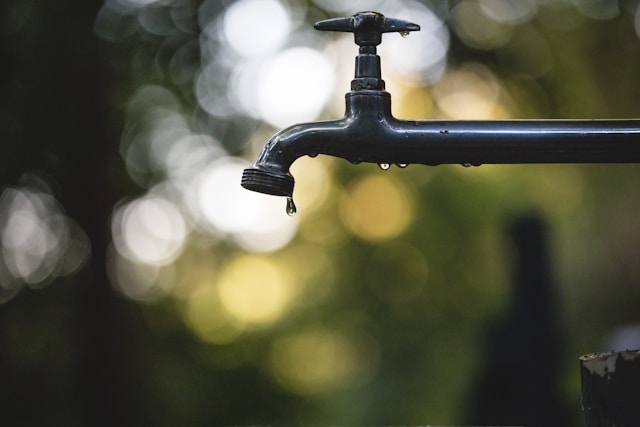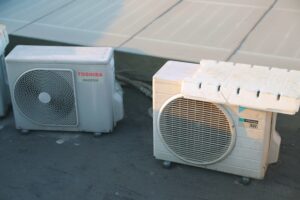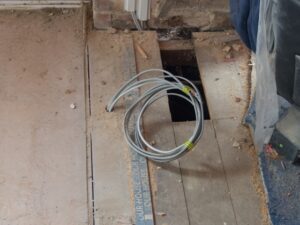Ever found yourself frustrated by low water pressure at home?
Whether it’s in the shower, the sink, or the dishwasher, poor water pressure can make everyday tasks a lot more difficult. The good news is that boosting the water pressure in your pressure tank is easier than you might think—and we’re here to help you get it right.
First things first: check the pressure switch settings. Adjusting them to the right levels can significantly improve your water pressure. It’s also important to ensure there are no blockages or leaks in the system, as these can cause pressure issues.
But why settle for guesswork when you can have expert guidance?
At Excel Mechanical, we specialize in providing tailored solutions for both your plumbing and HVAC needs. Our team understands how important it is to maintain optimal water pressure, and we’re here to ensure everything works smoothly—saving you time and stress.
With the right adjustments and professional help, you can enjoy a consistent, reliable water supply in your home or business without frustration.
In this blog, we will cover:
- How pressure tanks work and why they’re essential
- The key factors affecting water pressure in your system
- Expert solutions and adjustments to improve water pressure
Let’s dive in!
Understanding Water Pressure in Pressure Tanks
Water pressure in pressure tanks ensures a steady flow in your plumbing system. Knowing how these tanks function and the factors influencing pressure can help maintain efficiency.
The Role of Pressure Tanks in Water Systems
Pressure tanks are essential for storing water and stabilizing pressure in your system.
They hold a certain amount of water and air under pressure, which helps maintain a consistent water supply. When you use water, the tank provides it without needing the pump to constantly turn on and off. This not only reduces wear on your pump but also saves energy.
Pressure tanks are vital for residential and commercial setups, ensuring water is always available when required. Choosing the right tank size is important for optimal performance. Our team can guide you in selecting the best model tailored to your needs.
How Water Pressure Works
Water pressure results from the force exerted by water flowing through pipes and is measured in pounds per square inch (PSI).
The air compresses under pressure in a pressure tank, pushing water through your pipes when the tank is full. As you use water, the pressure drops until it reaches a minimum threshold, signaling the pump to refill the tank.
Maintaining proper PSI levels is critical for efficient water system operation. Low pressure can cause weak water flow, while high pressure can damage pipes and fixtures.
It’s important to monitor and adjust your system’s pressure settings regularly.
Factors Affecting Water Pressure in Pressure Tanks
Several factors can influence water pressure in pressure tanks.
- Material quality and tank size are key elements. Older tanks or those made from low-quality materials may not hold pressure well, reducing overall efficiency. Regular maintenance ensures your tank performs optimally.
- Additionally, the condition of your water pump and the pressure switch setting play significant roles. Blockages or leaks in your plumbing can also impact pressure.
Routine inspections and adjustments by experienced professionals help keep your system functioning smoothly.
Assessing Your Current Water Pressure
To increase the water pressure in your pressure tank, you must measure your system’s pressure accurately. You will need a water pressure gauge to start by assessing your current water pressure. This involves using the right tools to measure your water pressure and understanding what these measurements mean for your system.
Tools for Measuring Water Pressure
To accurately measure your system’s pressure, you will need a water pressure gauge.
This tool attaches easily to any faucet or hose bib, allowing you to get a precise reading. If you don’t own a gauge, you can often find them at hardware stores.
When using the gauge, ensure all other water appliances are off. This ensures an accurate reading. A typical home should have a pressure between 40 and 60 PSI. Anything outside this range may indicate a problem with your system.
It’s also beneficial to check for leaks or blockages in your system, as these can affect your results.
Interpreting Pressure Readings
Once you have your pressure reading, it’s essential to interpret what it means for your water system. A reading below 40 PSI might indicate insufficient pressure, while above 60 PSI could stress pipes.
Consider whether other factors, like recent plumbing work or changes in water usage, could affect your pressure. If adjustments are necessary, it might involve tweaking the pressure switch on your tank or addressing underlying issues with your check valve or pressure tank itself.
Pressure Tank Maintenance
Proper pressure tank maintenance is crucial to ensure consistent water pressure and prevent potential issues. Continue reading to learn about regular inspection, pinpointing signs of damage, and proactive care tips to keep your tank in optimal condition.
Regular Inspection and Cleaning
Inspecting and cleaning your pressure tank regularly can extend its lifespan.
Check the tank’s exterior for rust, dents, or other damages. Ensure the connections and fittings are tight and free from leaks.
Sediments can accumulate inside the tank over time, affecting performance. Flush the tank periodically to clear debris and improve efficiency. Inspect the air pressure using a pressure gauge.
Adjust it to the ideal level, usually 2 psi below the pump’s cut-in pressure.
Identifying Signs of Wear and Tear
Recognizing early signs of wear can help you prevent significant problems. Listen for unusual noises from the tank, which may indicate air leaks or mechanical issues.
Noticeable drops in water pressure suggest internal issues or blockages. Examine the tank for visible rust spots or corrosion, which can compromise its durability. Also, check for excessive pump cycling, which may indicate a problem with the tank’s bladder or diaphragm.
Preventative Maintenance Tips
Adopt preventative maintenance practices to keep your pressure tank running smoothly.
- Schedule regular inspections and service with professionals to ensure your system operates efficiently. We offer personalized services tailored to your needs and budget.
- Maintaining optimal air pressure is crucial. Keep it checked and adjusted to the recommended levels.
- If your area has hard water, use a water softener to reduce mineral buildup inside the tank.
- Also, consider installing a filtration system to prevent sediment from clogging your tank.
Working with our expert team can enhance system longevity and performance. Our commitment to quality and value makes us ideal for residential and commercial HVAC and plumbing services.
Troubleshooting Common Pressure Issues
Addressing common pressure tank issues often involves checking the air charge, ensuring the water pump functions correctly, and identifying any clogs in pipes or fixtures. These steps can help you increase water pressure effectively.
Air Charge in the Pressure Tank
Checking the air charge in your pressure tank is crucial for maintaining proper water pressure. Too little air can lead to lower water pressure. Use a tire pressure gauge to measure the tank’s air pressure.
If it’s below the manufacturer’s recommended level, add air using an air compressor. Ideally, pressure should be around 2 psi below the pump’s cut-on pressure. For instance, if your pump starts at 30 psi, the tank should be set at 28 psi.
Low air pressure can cause the pump to short cycle, wearing it out faster. To maintain efficient system function, regularly test and adjust the air charge.
Water Pump Function and Settings
Checking the condition and settings of your water pump is essential.
A malfunctioning pump can significantly reduce water pressure. Ensure that the pump is cycling properly and not overheating.
Inspect the pressure switch, which regulates your pump’s on/off cycles. The switch should correspond to the pressure tank’s recommended settings. Adjust the cut-in and cut-out settings to align with the pressure tank.
If issues persist, consider contacting professionals.
Clogged Pipes and Fixtures
Clogs in pipes and fixtures can severely restrict water flow, leading to pressure issues.
Examine your system for any build-up that might cause blockages.
Start by checking faucets and showerheads for mineral deposits, especially if you have hard water. Soaking them in vinegar can help dissolve buildup. Next, inspect pipes for any visible signs of clogging.
Clear the pipes using appropriate cleaning tools if you can safely do it.
For persistent flow problems, consult Excel Mechanical to benefit from professional evaluation and solutions. Our team ensures you can enjoy efficient water systems without unnecessary interruptions.
Adjusting and Optimizing Pressure Tank Settings
To ensure proper water pressure, it’s crucial to fine-tune your tank’s air pressure and adjust the pressure switch. Both adjustments directly affect how effectively your tank can maintain steady water pressure in your system.
Setting the Correct Air Pressure
Start by checking the air pressure in the tank using a reliable pressure gauge.
The correct air pressure setting is typically 2 psi below the cut-in pressure of your pump. For example, if your pump’s cut-in pressure is 30 psi, set the air pressure to 28 psi.
It’s important to check and maintain this setting regularly. Too much air pressure can cause the pump to short cycle, while insufficient pressure can lead to low water pressure in your home.
Adjusting the Pressure Switch
Begin by identifying the pressure switch, which usually has two small nuts to adjust settings. Typically, there are two adjustment nuts: one for the cut-in pressure and another for the cut-out pressure.
Turn the nut clockwise to increase the cut-in setting. Similarly, adjust the cut-out pressure to ensure the pump doesn’t work harder than necessary. A balance between these pressures is vital to maintaining efficiency and water flow.
Our services are tailored to meet individual needs, ensuring your system operates smoothly and efficiently.
Professional Solutions and Upgrades
Increasing water pressure in a pressure tank can sometimes require professional intervention. Solutions from licensed experts may involve evaluating the system’s components, recommending parts that improve efficiency, or installing devices that regulate and boost water pressure. These measures can bring lasting improvements.
When to Consult a Professional
Knowing when to call a professional is key.
If you’ve attempted simple fixes and still experience low water pressure, it might indicate deeper issues in your plumbing system. Persistent problems such as leaks, faulty pressure switches, or a failing well pump require expert evaluation.
Professionals can diagnose the root cause and provide targeted solutions. We offer a team of certified professionals who can handle intricate problems efficiently, ensuring your system is optimized and functions properly.
Our expertise in handling residential and commercial systems makes them ideal for thoroughly addressing these issues.
Pump and Tank Upgrades
Upgrading parts like the pump and pressure tank can significantly affect water pressure.
Older pumps may wear out and operate inefficiently over time. Technicians can recommend newer, more powerful, and energy-efficient models. Similarly, pressure tanks come in various sizes and capacities.
A larger tank may offer better performance, especially for households with high water demand.
Installation of Water Pressure Booster Systems
Another effective solution is installing a water pressure booster.
These devices increase the flow rate and help maintain steady pressure throughout your property. Professionals assess your current system and determine the best spot for installation. This often requires skilled hands to avoid potential disruptions during the process.
Selecting a reputable service ensures the use of premium booster systems that comply with industry standards. Our efficient installation techniques minimize downtime, giving you immediate improvements in water pressure.
This solves low-pressure problems and ensures water is distributed evenly and effectively in your location.
Safety Considerations and Compliance
Following safety protocols and ensuring compliance with local regulations is crucial when dealing with well-pressure tanks. This helps you avoid accidents and legal issues while maintaining an efficient system.
Adhering to Building Codes and Regulations
To ensure your well pressure tank system works safely, you need to follow local building codes. These regulations cover installation, maintenance, and the overall safety of your water system. Always check the specific requirements in your area. Staying informed and compliant protects your property and guarantees safe water usage.
Safety Precautions During Maintenance and Repairs
Maintenance and repair work on well pressure tanks require careful attention to safety.
Before starting any work, turning off the power supply to prevent electrical hazards is essential. You should also release pressure from the tank system to avoid sudden bursts.
Tools and equipment need to be in good condition to prevent injuries. Regular inspections help identify problems early, reducing the risk of accidents. If you’re unsure about performing repairs, it’s best to call professionals like Excel Mechanical.
We ensure all safety measures are followed, delivering high-quality service and peace of mind. Prioritizing safety minimizes risks and extends the life of your system.
Frequently Asked Questions
We know that water pressure issues can be a major headache. But you’re not alone—many homeowners and businesses face these challenges. Let’s dive into some of the most common questions people have when it comes to boosting water pressure in pressure tanks. With the right approach, you can easily improve the flow and ensure your system operates efficiently.
How can I improve the flow rate of my well system?
To boost the flow rate, inspect the entire system for clogs or leaks. Clean or replace filters and check for obstructions in the pipes. Regular maintenance can also prevent issues that lead to reduced flow. Our services ensure efficient operation and optimal performance for your systems.
What steps can I follow to increase the water pressure from my pressure tank?
Start by checking the air pressure in the tank. If needed, adjust the water pressure switch settings. Clean out clogged aerators on faucets. Adding a secondary pressure tank helps maintain consistent levels. Our professionals provide personalized solutions to fit your home’s needs.
How much air pressure is needed in a residential water pressure tank?
Typically, the air pressure should be 2 PSI below the cut-in pressure of your pump switch. For example, if your pump cuts in at 30 PSI, the tank pressure should be 28 PSI. Regularly checking this can prevent waterlogging and ensure efficient operation.
By upgrading to a larger pressure tank, will I experience a boost in water pressure?
Upgrading to a larger tank does not directly increase pressure but provides a more consistent flow by reducing pump cycling. This can lead to more stable water pressure over time. Consult Excel Mechanical to assess if a larger tank fits your system’s demands.
Can adjusting the water pressure switch contribute to higher pressure in my system?
Yes, adjusting the pressure switch can increase system pressure. Carefully increase the cut-in and cut-out settings, but avoid exceeding your system’s maximum capacity to prevent damage. Our skilled technicians can make these adjustments safely and effectively.
What methods exist to elevate the water pipe pressure from a tank?
You might install a booster pump to enhance the pressure. Check and clean any blockages, and verify the pipe diameter suits your pressure needs. Regular system checks by a professional team, like Excel Mechanical, ensure everything functions smoothly and efficiently.




